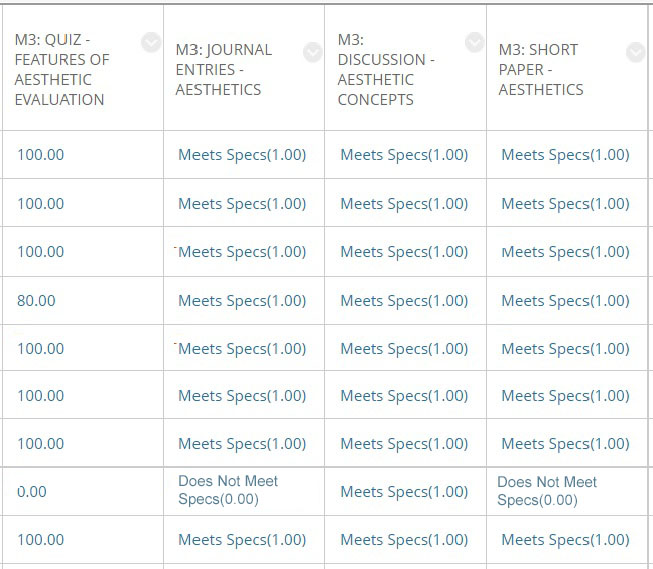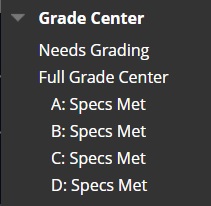Last revised: 10/07/2021 by JP
Overview
Are you looking to increase student motivation and the quality of their academic work? If yes, consider specifications grading. According to Linda B. Nilson, Ph.D. the traditional higher education grading method is broken and specifications grading offers a solution with benefits for both students and faculty. Nilson published her seminal work, Specifications Grading: Restoring Rigor, Motivating Students and Saving Faculty Time, in 2015. Since then, faculty have adopted her method, including some at UConn.
What is specifications grading?
In general, specifications grading involves binary grading that is based on up-front, clearly communicated pass/fail expectations. Due to it’s all or nothing nature, students are allowed (within limits) revision opportunities. Meeting expectations is aimed at B-level work or better, with the ultimate goal of elevating all students' performance. To help clarify satisfactory benchmarks with students, examples of acceptable work may be shared. Furthermore, bundles or modules are tied to the course’s learning outcomes, meaning students who earn higher grades must “demonstrate mastery of more skills and content...or both.” (p. 128)
Why use specifications grading?
Nilson asserts that if specifications is done well it will:
- Uphold high academic standards,
- Reflect student learning outcomes,
- Motivate students to learn,
- Motivate students to excel,
- Discourage cheating,
- Reduce student stress,
- Make students feel responsible for their grades,
- Minimize conflict between faculty and students,
- Save faculty time,
- Give students feedback they will use,
- Make expectations clear,
- Foster higher-order cognitive development and creativity,
- Assess authentically,
- Achieve high interrater agreement,
- Be simple. (p. 129-130)
When and how to use specifications grading?
Specifications grading can be used with any discipline or mode of delivery. It may be incorporated partially (selected assignments) or fully integrated into a course’s overall grading scheme. To use specifications correctly, the prerequisite is to begin with clearly defined student centered learning outcomes. If specifications grading will be fully integrated into the entire course design, then content and learning activities will also need to be chunked into modules or bundles.
Who at UConn uses specifications grading?
There are a number of UConn faculty integrating specifications grading into their courses. The following are a few examples with their corresponding syllabi.
-
- Mitch Green, PHIL 1108E - Environmental Philosophy
- Jamie Kleinman, PSYC 2300 - Abnormal Psychology
- Erin Rizzie, MATH 1131Q - Calculus I
Where to learn more about specifications grading?
CETL offers a recurring workshop titled, “Specification Grading: An Alternate Means of Assessing Learning Based on Mastery and Process.” Check out the CETL Workshop Events for the next offering. Nilson’s text, Specifications Grading: Restoring Rigor, Motivating Students and Saving Faculty Time, is available to borrow from CETL’s Library. In addition, you may also review the resources at the end of this article to learn more about specifications grading.
HuskyCT/BlackBoard Tools to Help with Specifications Grading
There are HuskyCT features that can help with facilitating and communicating specifications grading. Some features are more complicated than what is regularly used by most faculty, so it is recommended to reach out to Educational Technologies for assistance. Features you may consider using:

- Rubrics - To communicate satisfactory/unsatisfactory specifications and to provide feedback on students’ work. [Intermediate Skill]
- Grading Schemas - To set up text grading of “Meets specs/Does not meet specs” that will feed into the Grade Center. [Advanced Skill]
- Grade Center - Column information can be set up to communicate with students when they meet and don’t meet specifications, as well as track binary numbers for final grade calculations. [Intermediate - Advanced Skills]
- SMART Views - These views can be customized to filter students who have met different levels of course specifications to help assign final course grades of A, B, C, etc. [Advanced Skill]

Resources:
- Arnaud, C. H. (April 25, 2021) How an alternative grading system is improving student learning. Chemical & Engineering News, 99(15).
- Center for Teaching & Learning. Empowering Students Through Specs Grading, Humboldt State University.
- Hall, M. (April 11, 2018). What is Specifications Grading and Why Should You Consider Using It?. The Innovator Instructor (blog).
- Jone, J.B. (March 23, 2016). Experimenting with Specifications Grading. The Chronicle of Higher Education.
- Mittell, J. (February 16, 2016). Rethinking Grading: An In-Progress Experiment. JustTV (blog).
- Nilson, L. B. (2015). Specifications Grading: Restoring Rigor, Motivating Students and Saving Faculty Time. Stylus Publishing. This reading is available through the UConn CETL Library. If you would like to borrow the book contact Stacey Valliere, stacey.valliere@uconn.edu (860-486-2686), we are located in ROWE 331.
- Nilson, L.B. (January 19, 2016). Yes, Virginia, There's a Better Way to Grade. Inside Higher Ed.